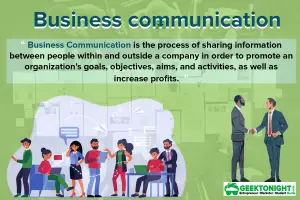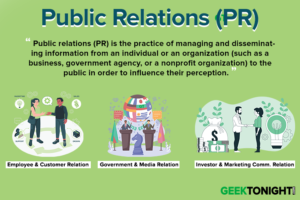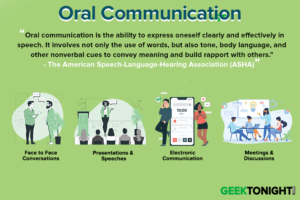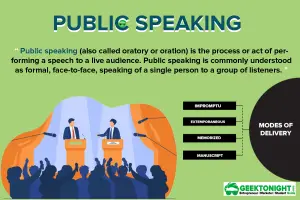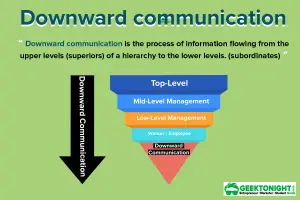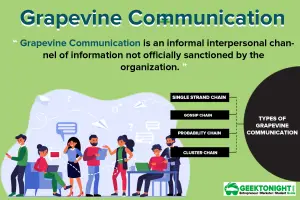Communication is the process of passing information and understanding the same from one person to another. Thus, communication means to understand information, facts or opinions of someone.
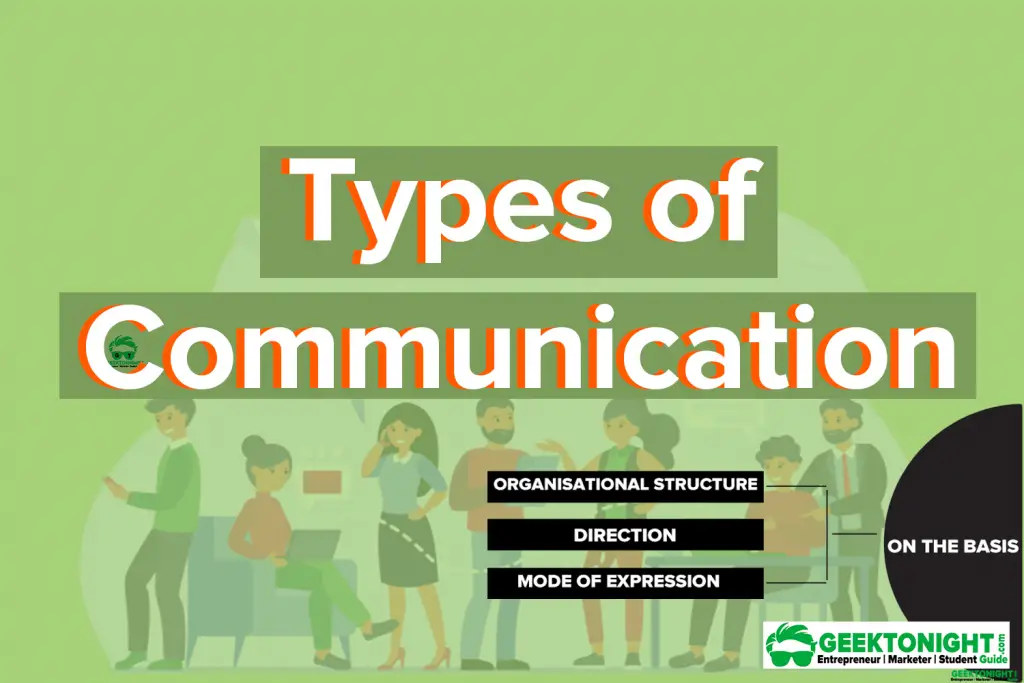
Communication may be in various forms, it may be classified on the following basis:
Types of Communication
- Formal Communication
- Informal Communication
- Downward Communication
- Upward Communication
- Horizontal Communication
- Diagonal Communication
- Non Verbal Communication
- Verbal Communication
- Oral Communication
- Written Communication
Table of Content
On the basis of Organisational Structure
In the organization structure of enterprise communication, there are two types of communication:
Formal Communication
Formal communication is a flow of information through formally established channels in an organization. These type of communication may be oral or written.
- Mostly controlled by managers
- It is hierarchical in nature and associated with the superior and subordinate relationship
- Generally linked with formal status and positions of a person
- It may be upward, downward and horizontal.
Advantages of formal communication
- Follows the principle of unity of command
- The orderly flow of information and systematic
- Helps in fixing responsibilities for better efficiency
- Managers have full control of nature and direction of communication
- Helps in maintaining authority relationship
- The flow of instruction is very specific, clear and definite.
- Helpful in maintaining direct contact with subordinates.
Disadvantage of formal communication
- It is a time-consuming process
- It lacks personal contacts and relationship
- It may be resisted and distorted
- It delays the communication message due to the formal procedure
- It obstructs the free, smooth and accurate circulation of information
Informal Communication
Informal Communication refers to communication on the basis of personal relations. It is a type of communication which is unstructured, unofficial and unplanned.
- It does not follow the formal channels established by the management
- It often flows between friends and intimates and related to personal rather than ‘positional’ matters.
- It cannot be demonstrated on the chart and not regulated by formal rules and procedure.
Informal communication is a result of social interaction and satisfies the natural desire of people to communicate with each other. Informal communication is helpful in countering the effects of work fatigue and monotony and serving as a source of job-related information.
It is also referred to as grapevine communication. Grape wine communication carries unofficial information. It is not a reliable source of communication. Managers should be very careful about such communication.
Advantages of informal communication
- It is a flexible and reliable channel of communication
- It creates mutual co-operation
- It may work as a valuable aid in communicating organizational rules, values and morale
- It is helpful in building teamwork in the organisation
- It provides effective feedback to the manager
- It supplements formal communication
- It creates successful public relations in the organisation
- If implemented efficiently, it will leads to the success
Disadvantages of informal communication
- It creates misunderstanding and uncertainty
- Due to different perceptions of the persons involved in whispering, chain interpretations of information may change
- It is difficult to believe in information as its source cannot be identified
- It sometimes leads to leak secret information
- The information passes through it is inaccurate and distorted
- It is difficult to control it as its flow and direction cannot be checked
On the basis of Direction
On the basis of directions communication may be of four types of communication:
Downward Communication
Communication that takes place from superiors to subordinates in a chain of command is known as downward communication.
Such type of communication may be in the form of orders, instructions, policies, programmes etc. It may be written or verbal.
The following messages are induced in this type of communication:
- Confirmation regarding performance
- Work assignment and directions
- Orders, guidance and responsibilities
- Ideological type of information
- Organisation Procedure and practices.
Advantages of downward communication
- It is helpful in controlling the subordinate
- It explains the plans and policies of the organisation to employees.
- It is a tool to delegate authority
- It is helpful to tie among employees at a different level
- It encourages the effectiveness of upward communication through feedback
- It helps in preparing the people to introduce change
Disadvantages of downward communication
- It tends to promote one-way communication
- It is time-consuming because information passes through various levels
- Sometimes a manager may filter the information or hold back some of the information due to fear that it might be unpalatable
- As communication takes time, sometimes message become ineffective and can lose significance
Upward Communication
When message are transmitted from bottom to top of the organisational hierarchy, it is known as upward communication.
The main function of upward communication is to supply information to top management. It is essentially participative in nature and can flourish only in a democratic organisational environment. It may be in the form of progress report, suggestions, grievances, complaints etc.
Advantages of upward communication
- Management can use feedback effectively in their plan and procedures
- Help subordinate to communicate their views to top management
- It supports innovative ideas and suggestion
- Support in harmony and mutual co-operation among management and subordinate
- The managers are able to evaluate the impact of communication
Disadvantages of upward communication
- Subordinate provides only favourable information to upper management
- It may be discouraged due to lack of proper response of top management
- It takes a lot of time to pass the message to higher level
- Possibility of wilful manipulation of information to attain personal goals.
- There arise a threat that superior may react negatively
Horizontal Communication
When communication takes place between two or more persons who are working at same levels it is known as horizontal communication.
This type of communication takes place mostly during a committee meeting or conferences. The main object of such communication is to establish inter-departmental co-ordination.
Advantages of horizontal communication
- It helps in avoiding duplication of work
- It solves inter-department conflicts
- It facilitates establishing co-ordination between different departments of the organisation
- Communication process is computed smoothly without any barrier.
- It helps in maintaining social and emotional support among the peer group.
Disadvantages of horizontal communication
- There is a lack of motivation to communicate
- Usually, they hide information due to rivalry between them
- It lacks authoritativeness
Diagonal Communication
Diagonal communication is an exchange of information between the persons at a different level across departmental lines.
This type of communication is used to spread information at different levels of an organization to improve understanding and co-ordination so as to achieve organisational objectives.
Thus, where the persons who are neither working in the same department nor has similar level are communicating, it is said to be diagonal communication. It cuts across the levels of organisational structure.
Advantages of diagonal communication
- It increases organisational effectiveness
- It facilitates organisational change
- It creates integrity and harmony in the organisation
- It helps to speed up the action and save time
Disadvantages of diagonal communication
- It violates the principle of unity of command
- It is an unsystematic manner of communicating.
On the basis of Mode of Expression
Non Verbal Communication
Communication through expressions, gestures or posture is nonverbal communication. It refers to the flow of information, through facial expressions, tone of voice and other body movements.
In other words, it is a type of communication other than words. It conveys the feeling, emotions, attitude of a person to another. A person can communicate his feeling to others quickly and economically by using a non-verbal form of communications. This does not require the use of words as a person can express his feelings by his body language.
Some important of nonverbal communication are:
- Body Language: Posture, Gesture, Eye Contact, Silence etc.
- Proximity: Space (intimate space, public space), Time, Surroundings etc.
- Para Language: Voice, Volume, Pause, Pitch, Proper stress etc
Advantages of non verbal Communication
- It is reliable source of information
- Message may be conveyed quickly
- It is an economic way of communications
- It creates better-understanding
Disadvantages of non verbal Communication
- Expressions and gestures are seen by anyone so it lacks secrecy.
- It creates misunderstanding due to non-understanding of the gestures
- It requires the physical presence of both parties
- Long and detailed message cannot be conveyed
- The meaning of gesture changes according to time and place, thus it is difficult to understand universally
- There is no written proof in case of any dispute in future.
Verbal Communication
Verbal Communication is an exchange of information by words either written or oral. Verbal communication consists of speaking, listening, writing, reading etc. It is the most preferred mode of communication.
It may be of two types of Verbal Communication:
Oral Communication
When a message is expressed through spoken words, it may be either through face to face conversations or with the help of electronic mode such as telephone, cellular phone, etc.
It may also be in the form of informal conversation, group discussions, meeting etc. It is a more effective means of exchange of information because the receiver not only hears the message but also observes the physical gestures of the speaker.
Advantages of oral communication
- Oral communication is useful in providing good leadership
- It provides an opportunity to participate in all the members in decision making
- It saves time and message reach to the receiver very quickly
- It is an economic source of communications
- It is more effective as body language can be observed along with the hearing of the message
- Reaction can be received easily and quickly
- The message can be conveyed clearly because, in case of any confusion, the clarification can be sought immediately.
Disadvantages of oral communication
- It requires the presence of both parties, i.e. sender and receiver
- The major drawback of this type of communication is lack of proof, thus it has no legal validity
- It is not suitable when the messages are lengthy
- It does not provide sufficient time for thinking before conveying the message
- It involves a high cost if both parties are at distance place
- The message can be distorted.
Written Communication
When opinions are exchanged in written form, rather than by spoken words, it is knows as written communication.
It may be expressed through charts, pictures and diagrams. It includes newspapers, reports, letters, circulars magazines etc. While using written communication, words should be select very carefully because message ones sent can not be altered. it is formal in nature and cannot be overlooked.
Advantages of written communication
- It provides a future reference: it becomes a permanent record and beneficial for formulating new policies.
- It is accurate. Mistakes are not likely to occur as it is open for verification and its authenticity can be checked.
- It does not require the physical presence of both parties.
- It ensures transmission of information in a uniform manner
- It is useful to transmit complex information and it facilitates the assignation of responsibilities
- It usually removes conflicts and misunderstanding
- It facilitates to convey a message to a large number of persons at the same time
- Written communication is acceptable as a legal document.
Disadvantages of written communication
- It is a time and money consuming way of communication
- It lacks secrecy because message passes through various hands, thus, it is said to be a double-edged weapon
- It is not useful in emergency circumstances
- It has no chance to alter the message ones transmitted
- It is not possible to get immediate feedback
- It becomes unimpressive if drafted poorly
- It may be interpreted in the wrong manner
- It requires unnecessary formalities.
Business Communication Notes
(Click on Topic to Read)
Reference
- Murphy, Hildebrandt (1991), Effective Business Communication, McGraw Hill, New York.
- Business Communication: “ K.K. Sinha, Golgotia Publishing Company.
- Business Communication: “M.K. Sehgal, Vandana Khetrapal, Excel Books.
- Essentials of Business Communication: Rajendra Pal, J.S Korlahalli, Sultan Chand & Sons.
Go On, Share & Help your Friend
Did we miss something in Business Communication Tutorial or You want something More? Come on! Tell us what you think about our post on Types of Communication | Business Communication in the comments section and Share this post with your friends.
Business Communication Notes
(Click on Topic to Read)
- What is Business Communication?
- What is Communication?
- Types of Communication
- 7 C of Communication
- Barriers To Business Communication
- Oral Communication
- Types Of Non Verbal Communication
- What is Written Communication?
- What are Soft Skills?
- Interpersonal vs Intrapersonal communication
- Barriers to Communication
- Importance of Communication Skills
- Listening in Communication
- Causes of Miscommunication
- What is Johari Window?
- What is Presentation?
- Communication Styles
- Channels of Communication
- Hofstede’s Dimensions of Cultural Differences and Benett’s Stages of Intercultural Sensitivity
- Organisational Communication
- Horizontal Communication
- Grapevine Communication
- Downward Communication
- Verbal Communication Skills
- Upward Communication
- Flow of Communication
- What is Emotional Intelligence?
- What is Public Speaking?
- Upward vs Downward Communication
- Internal vs External Communication
- What is Group Discussion?
- What is Interview?
- What is Negotiation?
- What is Digital Communication?
- What is Letter Writing?
- Resume and Covering Letter
- What is Report Writing?
- What is Business Meeting?
- What is Public Relations?
Business Communication Notes
(Click on Topic to Read)
- What is Business Communication?
- What is Communication?
- Types of Communication
- 7 C of Communication
- Barriers To Business Communication
- Oral Communication
- Types Of Non Verbal Communication
- What is Written Communication?
- What are Soft Skills?
- Interpersonal vs Intrapersonal communication
- Barriers to Communication
- Importance of Communication Skills
- Listening in Communication
- Causes of Miscommunication
- What is Johari Window?
- What is Presentation?
- Communication Styles
- Channels of Communication
- Hofstede’s Dimensions of Cultural Differences and Benett’s Stages of Intercultural Sensitivity
- Organisational Communication
- Horizontal Communication
- Grapevine Communication
- Downward Communication
- Verbal Communication Skills
- Upward Communication
- Flow of Communication
- What is Emotional Intelligence?
- What is Public Speaking?
- Upward vs Downward Communication
- Internal vs External Communication
- What is Group Discussion?
- What is Interview?
- What is Negotiation?
- What is Digital Communication?
- What is Letter Writing?
- Resume and Covering Letter
- What is Report Writing?
- What is Business Meeting?
- What is Public Relations?


